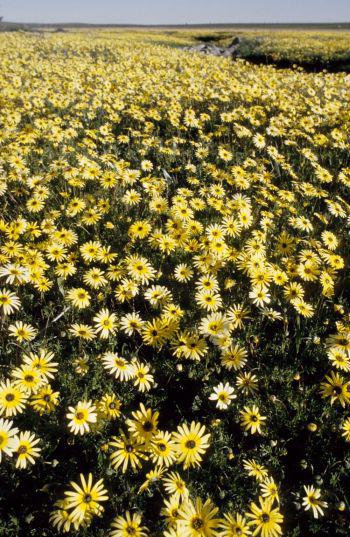Arctotheca calendula
Arctotheca calendula (L.) Levyns
Family: Asteraceae
Common names: Cape marigold, Cape weed, Cape dandelion (Eng.); botterblom, gousblom, soetgousblom, tonteldoekblom, Kaapse madeliefie (Afr.); isiqwashumbe (isiXhosa)
Introduction
A weedy annual that can be planted as a showy ground cover or bedding plant for spring and early summer display.

Description
Description
This species is a tufted to sprawling annual herb, growing up to 250 mm high. The basal leaves form a rosette and are roughly hairy above, woolly below. They have deeply divided margins. The daisy-like flowers, up to 60 mm, across are a pale yellow, with a darker yellow ring and a black or yellow centre, and are borne singly on roughly hairy stalks. The fruits are woolly with a chaffy pappus.
Flowering time is mainly in winter, spring and early summer (July to November).

Conservation Status
Status
According to the Red List of South African Plants, its conservation status is Least Concern (LC).
Distribution and habitat
Distribution description
The Cape Dandelion is widespread and occurs in coastal areas and along roadsides, old farmlands or on disturbed soil in Namaqualand and the Karoo to the Cape Peninsula and eastwards to Humansdorp and extending into KwaZulu-Natal. In the Cape it is well known by its common name, the Cape weed.

Derivation of name and historical aspects
History
The name Actotheca is derived from Greek words arktos meaning 'a bear', and theke meaning 'a capsule or a case', referring to the densely woolly fruits. The species name calendula probably refers to its resemblance to the European genus Calendula. It means 'little calendar' and comes from the Greek word kalendae, meaning 'the first day of the month', and could refer to its long-flowering period. Its common names gousblom is from the Dutch name for Calendula officinalis, and is applied to many other yellow- or orange-flowered daisies.
Actotheca is a small genus of five species in southern Africa.
Ecology
Ecology
The flowers are mostly visited, and pollinated, by bees and butterflies.
Uses
Use
In earlier times, the grey felt on the undersides of the leaves of many species in the daisy family, including Arctotheca calendula, was scraped off and used as tinder (tontel ). When scraped off this felt resembles a miniature cloth (doek ), which is where this species gets its other Afrikaans common name, tonteldoekblom
This plant is a useful ground cover or edging plant that can be used in the garden for a colourful display.
Growing Arctotheca calendula
Grow
It is a good ground cover, able to grow in any garden soil, although it is advisable to add plenty of compost. The Cape Dandelion grows best in full sun and requires a moderate amount of water. It is hardy to moderate frost.
This plant is easily propagated from seed sown in autumn. If the plants are left to go to seed, it seeds itself freely in the garden.
References
- Goldblatt, P. & Manning, J. 2000. Cape Plants. A conspectus of the Cape flora of South Africa. Strelitzia 9. National Botanical Institute, Pretoria & Missouri Botanical Garden, Missouri.
- Jackson, W.P.U. 1990. Origins and meanings of names of South African plant genera. University of Cape Town.
- Joffe, P.1993. The gardener’s guide to South African plants. Tafelberg Publishers, Cape Town.
- Le Roux, A. & Schelpe, T. 1988. Namaqualand. South African Wild Flower Guide 1. Botanical Society of South Africa, Cape Town.
- Manning, J.C., Goldblatt, P. 1996. West Coast. South African Wild Flower Guide 7. Botanical Society of South Africa, Cape Town
- Smith, C.A. 1966. Common names of South African plants. Memoirs of the Botanical Survey of South Africa No. 35. Government Printer, Pretoria.
Credits
Moeketsi S. Letsela & Sharon Turner
Walter Sisulu National Botanical Garden
March 2002
Updated by Alice Notten
Kirstenbosch National Botanical Garden
September 2016
Plant Attributes:
Plant Type: Bi/Annual, Ground Cover
SA Distribution: Eastern Cape, KwaZulu-Natal, Northern Cape, Western Cape
Soil type: Sandy, Loam
Flowering season: Spring, Early Summer, Winter
PH: Acid, Neutral
Flower colour: Black, Yellow
Aspect: Full Sun
Gardening skill: Easy
Special Features:
Horticultural zones











Rate this article
Article well written and informative
Rate this plant
Is this an interesting plant?
Login to add your Comment
Back to topNot registered yet? Click here to register.